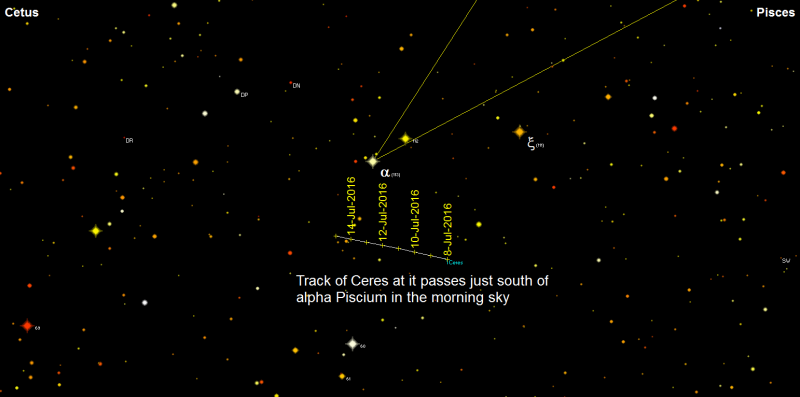2016 July 6
See Ceres in the morning sky
Ceres, the first asteroid to be discovered, was found by Giuseppe Piazzi on 1801 Jan 1. Following its discovery it was thought to be a new planet and it was only after the discovery of many similar bodies in the years that followed (i.e. they were in similar orbits, showed planetary like movement against the background stars but showed little or no disk through the telescope) that the term asteroid was coined. Ceres is the largest of the asteroids with a diameter of roughly 945km and is thought to comprise approximately one third of the entire mass of the asteroid belt.
Ceres has intrigued planetary scientists since 2004 when the Hubble Space Telescope first imaged bright patches on the dwarf planet’s surface. It was originally thought that these were ice but the arrival of the Dawn spacecraft in spring 2015 (Dawn was launched in September 2007 from Cape Canaveral and has travelled to Ceres after first visiting and orbiting 4 Vesta en-route) has now shown that they are most likely salt deposits left behind by sublimating water ice.
Ceres reaches opposition this year on October 21 when its magnitude will be 7.4 but it is also visible during the next few days, albeit much fainter (mag 9.1), but with a nearby mag 3 star to act as a guide. The chart below shows the track of Ceres passing just over 1 degree south of mag 3.2 alpha Piscium from July 8 to 14. At 03:00UTC on July 10 Ceres will lie at an altitude of around 22 degrees in the Moon free east south-east sky from southern England.
This is an ideal opportunity to record this dwarf planet passing its bright star companion and sketches or images on a daily basis should easily show its movement. Weather permitting of course.

https://britastro.org/wp-content/uploads/2022/02/Ceres-NASA-image.jpg
https://britastro.org/wp-content/uploads/2022/02/Ceres-NASA-image.jpg
https://britastro.org/wp-content/uploads/2022/02/Ceres-NASA-image.jpg
https://britastro.org/wp-content/uploads/2022/02/Ceres-NASA-image.jpg
https://britastro.org/wp-content/uploads/2022/02/Ceres-NASA-image.jpg
https://britastro.org/wp-content/uploads/2022/02/Ceres-NASA-image.jpg
https://britastro.org/wp-content/uploads/2022/02/Ceres-NASA-image.jpg
https://britastro.org/wp-content/uploads/2022/02/Ceres-NASA-image.jpg
https://britastro.org/wp-content/uploads/2022/02/Ceres-NASA-image.jpg
https://britastro.org/wp-content/uploads/2022/02/Ceres-NASA-image.jpg
https://britastro.org/wp-content/uploads/2022/02/Ceres-NASA-image.jpg
https://britastro.org/wp-content/uploads/2022/02/Ceres-NASA-image.jpg
https://britastro.org/wp-content/uploads/2022/02/Ceres-NASA-image.jpg
https://britastro.org/wp-content/uploads/2022/02/Ceres-NASA-image.jpg
https://britastro.org/wp-content/uploads/2022/02/Ceres-NASA-image.jpg
https://britastro.org/wp-content/uploads/2022/02/Ceres-NASA-image.jpg
https://britastro.org/wp-content/uploads/2022/02/Ceres-NASA-image.jpg
https://britastro.org/wp-content/uploads/2022/02/Ceres-NASA-image.jpg
https://britastro.org/wp-content/uploads/2022/02/Ceres-NASA-image.jpg
https://britastro.org/wp-content/uploads/2022/02/Ceres-NASA-image.jpg
https://britastro.org/wp-content/uploads/2022/02/Ceres-NASA-image.jpg
https://britastro.org/wp-content/uploads/2022/02/Ceres-NASA-image.jpg
https://britastro.org/wp-content/uploads/2022/02/Ceres-NASA-image.jpg
https://britastro.org/wp-content/uploads/2022/03/Ceres-NASA-image.jpg
https://britastro.org/wp-content/uploads/2022/03/Ceres-NASA-image.jpg
https://britastro.org/wp-content/uploads/2022/03/Ceres-NASA-image.jpg
https://britastro.org/wp-content/uploads/2022/03/Ceres-NASA-image.jpg
https://britastro.org/wp-content/uploads/2022/02/Ceres-NASA-image.jpg
https://britastro.org/wp-content/uploads/2022/02/Ceres-NASA-image.jpg
https://britastro.org/wp-content/uploads/2022/02/Ceres-NASA-image.jpg
https://britastro.org/wp-content/uploads/2022/02/Ceres-NASA-image.jpg
https://britastro.org/wp-content/uploads/2022/02/Ceres-NASA-image.jpg
https://britastro.org/wp-content/uploads/2022/02/Ceres-NASA-image.jpg
https://britastro.org/wp-content/uploads/2022/02/Ceres-NASA-image.jpg
https://britastro.org/wp-content/uploads/2022/02/Ceres-NASA-image.jpg
https://britastro.org/wp-content/uploads/2022/02/Ceres-NASA-image.jpg
https://britastro.org/wp-content/uploads/2022/02/Ceres-NASA-image.jpg
https://britastro.org/wp-content/uploads/2022/02/Ceres-NASA-image.jpg
https://britastro.org/wp-content/uploads/2022/02/Ceres-NASA-image.jpg
https://britastro.org/wp-content/uploads/2022/02/Ceres-NASA-image.jpg
https://britastro.org/wp-content/uploads/2022/02/Ceres-NASA-image.jpg
https://britastro.org/wp-content/uploads/2022/02/Ceres-NASA-image.jpg
https://britastro.org/wp-content/uploads/2022/02/Ceres-NASA-image.jpg
https://britastro.org/wp-content/uploads/2022/01/Ceres-NASA-image.jpg
https://britastro.org/wp-content/uploads/2022/02/Ceres-NASA-image.jpg
https://britastro.org/wp-content/uploads/2022/02/Ceres-NASA-image.jpg
https://britastro.org/wp-content/uploads/2022/02/Ceres-NASA-image.jpg
https://britastro.org/wp-content/uploads/2022/01/Ceres-NASA-image.jpg
https://britastro.org/wp-content/uploads/2022/01/Ceres-NASA-image.jpg
https://britastro.org/wp-content/uploads/2022/01/Ceres-NASA-image.jpg
https://britastro.org/wp-content/uploads/2022/01/Ceres-NASA-image.jpg
https://britastro.org/wp-content/uploads/2022/01/Ceres-NASA-image.jpg
https://britastro.org/wp-content/uploads/2022/01/Ceres-NASA-image.jpg
https://britastro.org/wp-content/uploads/2022/01/Ceres-NASA-image.jpg
https://britastro.org/wp-content/uploads/2022/02/Ceres-NASA-image.jpg
https://britastro.org/wp-content/uploads/2022/01/Ceres-NASA-image.jpg
https://britastro.org/wp-content/uploads/2022/01/Ceres-NASA-image.jpg
https://britastro.org/wp-content/uploads/2021/11/Ceres-NASA-image.jpg
https://britastro.org/wp-content/uploads/2021/11/Ceres-NASA-image.jpg
https://britastro.org/wp-content/uploads/2021/11/Ceres-NASA-image.jpg
https://britastro.org/wp-content/uploads/2021/11/Ceres-NASA-image.jpg
https://britastro.org/wp-content/uploads/2021/07/Ceres-NASA-image.jpg
https://britastro.org/wp-content/uploads/2021/07/Ceres-NASA-image.jpg
https://britastro.org/wp-content/uploads/2016/07/Ceres-NASA-image.jpg
https://britastro.org/wp-content/uploads/2022/02/Ceres-NASA-image.jpg
https://britastro.org/wp-content/uploads/2022/02/Ceres-NASA-image.jpg
https://britastro.org/wp-content/uploads/2022/02/Ceres-NASA-image.jpg
https://britastro.org/wp-content/uploads/2022/02/Ceres-NASA-image.jpg
https://britastro.org/wp-content/uploads/2022/02/Ceres-NASA-image.jpg
https://britastro.org/wp-content/uploads/2022/02/Ceres-NASA-image.jpg
https://britastro.org/wp-content/uploads/2022/02/Ceres-NASA-image.jpg
https://britastro.org/wp-content/uploads/2022/02/Ceres-NASA-image.jpg
https://britastro.org/wp-content/uploads/2022/02/Ceres-NASA-image.jpg
https://britastro.org/wp-content/uploads/2022/02/Ceres-NASA-image.jpg
https://britastro.org/wp-content/uploads/2022/02/Ceres-NASA-image.jpg
https://britastro.org/wp-content/uploads/2016/07/Ceres-passing-south-of-alpha-Piscium.png
https://britastro.org/wp-content/uploads/2022/02/Ceres-NASA-image.jpg
https://britastro.org/wp-content/uploads/2022/02/Ceres-NASA-image.jpg
https://britastro.org/wp-content/uploads/2022/02/Ceres-NASA-image.jpg
https://britastro.org/wp-content/uploads/2022/02/Ceres-NASA-image.jpg
https://britastro.org/wp-content/uploads/2022/02/Ceres-NASA-image.jpg
https://britastro.org/wp-content/uploads/2022/02/Ceres-NASA-image.jpg
https://britastro.org/wp-content/uploads/2022/02/Ceres-NASA-image.jpg
https://britastro.org/wp-content/uploads/2022/02/Ceres-NASA-image.jpg
https://britastro.org/wp-content/uploads/2022/02/Ceres-NASA-image.jpg
| The British Astronomical Association supports amateur astronomers around the UK and the rest of the world. Find out more about the BAA or join us. |
